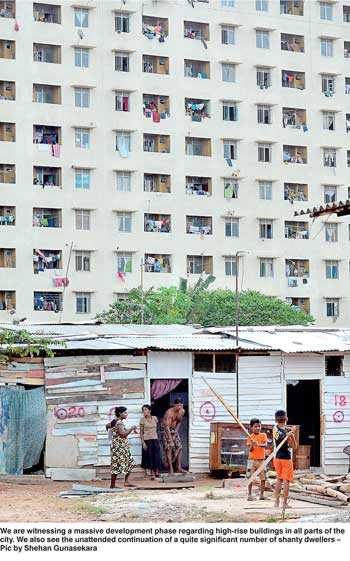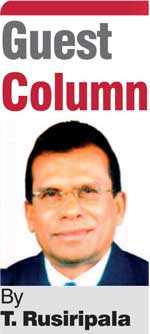Sunday Dec 07, 2025
Sunday Dec 07, 2025
Friday, 31 August 2018 00:10 - - {{hitsCtrl.values.hits}}
 Historical percept
Historical percept
Two thousand five hundred years ago, there lived a man called Hippodamus of Miletus who is considered to be “the father of European urban planning”. He was an ancient Greek architect, urban planner, physician, mathematician, meteorologist and philosopher. Aristotle called him the “the father of city planning”. This recognition continued till recent periods until the 20th century. His concepts became the foundation for the development of the well-renowned Greek-Roman urbanisation. It was generally regarded as the cornerstone of modern Western culture.
The fast growth of industrialised cities during the 19th century and the consequential adversities and evils of the poor and the disadvantaged attracted public concerns leading to championing of the urban planning models focusing on mitigating the dire living conditions of the factory workers and ordinary citizens. Urban planning soon entered the phase of scientific concepts, behavioural relationships and the need to define theories. Today the principal planning procedure acknowledges accepted theories associated with multifarious approaches.
Modern concepts
Urban planning can address different issues depending on the situation and relevancy. E.g. Urban renewal of existing cities which stand affected due to declining conditions and environmental hazards. It is also associated with the need to meet the challenges of urban growth. The latest theory manifestation in this regard is the sustainable development which term has become universal, encompassing the full spectrum of planning goals. Today the shifted focus is towards more sophisticated aspirations such as creativity, innovation and liveability. Cities play a great role in the economic progress of a nation as the showpiece for innovation, creativity and knowledge.
Cities the world over have undergone development and changes with the focus shifted towards more modern and refined aspirations of raising the country’s image in a global scenario. In today’s context of globalisation and technological advancement, the competitive advantage of a nation is more reliant on enterprise and knowledge production. Those cities that have developed on this basis play a greater role as the forefront showpiece of the country’s economic progress.
The fast urbanisation of Singapore becoming an enviable model-city beating all others in the entire South Asian region is the best example in this regard. It earned the nickname of being called ‘Singapore Unlimited’ due to its ability to expand beyond its shores exploring economic opportunities with a driving force with motivation growing simultaneously with the ongoing city development and urbanisation, facilitating such ventures.
Singapore is an island nation with about 5.5 million inhabitants with a very small domestic market and no resources compared to other neighbouring nations. Nevertheless, with concerted planning, the scarcities of natural resources such as water and the shortage of land has been transformed into an impetus for imagination, resourcefulness and a culture of ingenuity in facing the constraints and restrictions faced as a nation.
The Singapore Government and the town planners placed a very high priority towards building a clean and green environment when their economy was still young. They strongly believed that a good environment would not only help to improve the quality of life but would contribute to the future growth and enhancement of the economy. The Government approached the World Bank when they felt that the need was most significant. They had to find ways to obtain assistance to overcome the financial restraints in order to implement the development of environmental infrastructure which they considered as critical during the early years. I wish to quote the Singaporean authorities in this regard to elucidate their thinking: “While the costs are upfront and immediate, the gains and benefits will be demonstrated long-term.”
They were able to face the challenges of rapid population growth and pressing land demand in this manner successfully as demonstrated today. Now they are stepping into new directions with a national blueprint for sustainable development with initiatives to promote “sky-rise greenery,” the latest concept of landscaping for urban spaces and high rise buildings granting incentives for developers to include green effects in the form of sky terraces and roof top gardens.
 Where do we stand? Colombo!
Where do we stand? Colombo!
We are witnessing a massive development phase regarding high-rise buildings in all parts of the city. We also see the unattended continuation of a quite significant number of shanty dwellers; 15,000 such families out of a total estimated household of 120,000 is by no means a negligible number. Most of these shanty dwellers are unauthorised occupants of slums and squatter colonies. Their living conditions and standards are nowhere close to any decent human levels. The health hazards such living conditions contribute to are immense and despicable.
Of the total, majority of permanent householders are living under either average conditions or below average standards. This factor too is not something that could be viewed as a private affair or not as any ones’ responsibility. Many households which used to be single-family occupancy units are now subdivided into smaller compartments. The overcrowding of these households has led to lack of privacy, inadequate lighting and ventilation, and sometimes to a deprivation of basic sanitation facilities. Most of these owner occupied units have become urban slums due to these conditions. Can such a situation continue to remain overlooked any longer? While there is an increasing demand for housing in this sector, pressure for schemes related to road improvements, sanitation facilities, back lanes, open spaces, etc. is becoming acute.
Many structures are coming up under the aegis of the Colombo Municipality itself in a rather haphazard, unplanned manner to fulfil the whims and fancies of some raw and half-grown political greenhorns thrown into the council. The resulting outlook and disposition is not conducive to be anywhere close to environmental conditions of a liveable city. Are we focusing seriously on these issues?
Increasing population and the existing road network conditions has precipitated a serious traffic congestion problem. The number of persons commuting to work by cars has increased many folds during the last few years adding to the traffic menace. The inadequacy and the continuing basic level of the road network have contributed to this in a big way while the lack of a good and dependable Public transport system appears to be another principal factor. The introduction of a well-planned traffic management system would ease the situation but is not practicable at the moment due to the inability to promote public transport as a suitable substitute.
The plans and projections of the Colombo Municipality with regard to these issues do not appear to be adequate and cohesive. It has been the practice prevailing over a period of time to look forward to the assistance of international donors, lending organisations and such bodies to assist us in addition to providing funds to overcome our serious infrastructure shortcomings.
The World Bank Group with several bodies and organisations such as IFC, IDA and other international agencies like ADB have committed already to some ongoing projects in the CMC. The WB sponsored Metro Colombo Urban Development project (2008) was started with the objective of reducing flooding damages; Capacity development of local authorities to rehabilitate, improve and maintain infrastructure and services; Implementation including monitoring, procurement and equipment, etc. The question before us is whether we have shown adequate progress during a decade-old period that has passed.
International organisations have also expressed concerns about the need to develop wetlands and the utilisation of this natural asset as a unique opportunity for image building in order to increase the GDP.
It has been estimated that the perennial flood damages cause annual losses exceeding approximately 1% of the GDP. The observations indicate that this valuable resource is degrading fast at an alarmingly high rate reducing the area of wetlands.
The CMC and the way forward
The Municipality had faced many political setbacks as well as administrative problems before a stable governance was established. The current scenario is quite favourable to move away and forward from this stalemate. Therefore a serious concentration is required in developing a sustainable policy plan for the future, taking the advantage of the political manifestations of the country.
Two major political parties are united to govern the country and in so far as the CMC is concerned this combination of powers has provided a strong base for moving forward with a political strength to tackle demanding needs with professional initiatives in a planning process. Current complexities require a flexible and innovative approach to the issues facing citizens leaving behind petty and self-centred attitudes and political hankerings.
The Government will gain public confidence when plans are developed with bolder visions. What the people need is a progress that will override the past imperfections and weaknesses to achieve a modern and economically active liveable city. We need our city to provide good transportation connectivity, good quality housing, satisfying leisure opportunities and a good business environment.
To achieve this there should be harmony and understanding between all government agencies and departments with the city authorities. All concepts should be backed by consultation and consensus. There has to be a closer coordination among the government agencies that manage and execute nation- building programs. Master plans have to be developed which have to be reviewed and updated regularly with a great degree of transparency.
A process of ongoing and continuing consultation with the public should be established. Society should actively participate in the infrastructural improvements as well as other areas such as traffic control and management. Public involvement is essential for the successful implementation and materialisation of any plan. City dwellers, with a high degree of literacy and wide exposure to modern concepts elsewhere are better suited to engage in such a consultative process.
(The writer is a Member of the Colombo Municipal Council.)